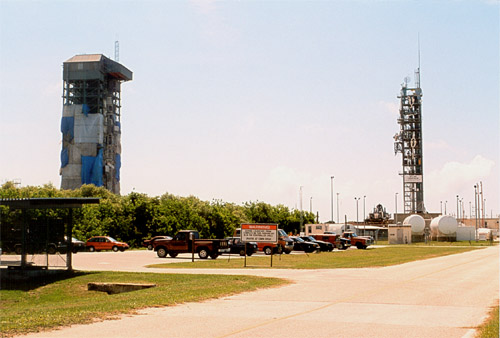
| Complex 36, Pad B |

| Complex 36, Pad B |
This is Pad B at Complex 36. The large tower on the left is the Mobile Service Tower (MST), which is used to erect the vehicle and mate and service the payload. As the name implies, the MST is mobile; the entire structure is rolled away on rails prior to launch (it is in this position in the picture above). The tower on the right is the Umbilical Tower (UT). It is fixed, and provides power, instrumentation, and propellants to the launch vehicle and spacecraft prior to launch.
Complex 36 was built in 1961 with a single launch pad (Pad A, not visible in the picture above) to support Atlas/Centaur launches. Pad B was added in 1964. In late 1989, NASA transferred control of Complex 36 to the U.S. Air Force and General Dynamics for both military and commercial operations. Since that time, Atlas II series vehicles (Atlas II, Atlas IIA, and Atlas IIAS) have launched several military and commercial payloads. Complex 36 is one of the few remaining active launch sites.
The Atlas launch vehicle consists of an Atlas booster and a Centaur upper stage (this combination is sometimes referred to as "Atlas/Centaur"). The Atlas vehicle has launched many important payloads from Complex 36, including Surveyor, Mariner, Pioneer, and Intelsat.
The sign
in the center of the photo reads as follows:
| WARNING |
|
DURING LAUNCHES FROM COMPLEX 36, THIS PARKING LOT IS IN THE CONTROLLED AREA PARK AT OWN RISK |
|
|
See an aerial view of the Complex |
|
|
Go back to the blockhouse at Complexes 1-4 |
| Tour home | CCAFS map | Website map |